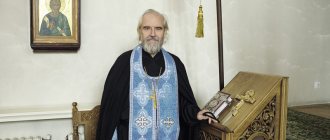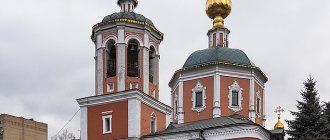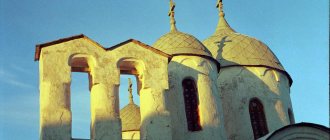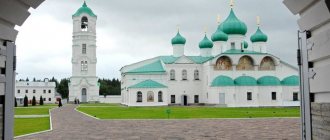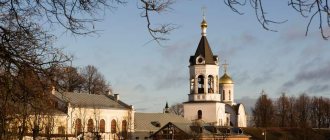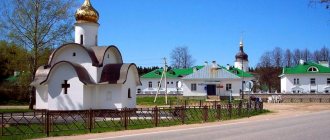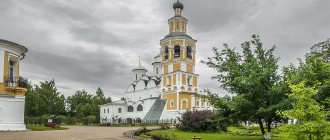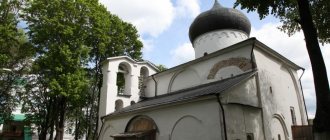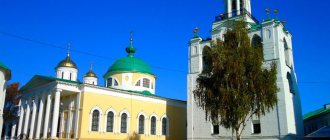Address: Maslieva st., 25
Opening hours: from 8.30 to 19.00
Sergiev Posad is a small town near Moscow, well known for its holy Orthodox monasteries, temples and monasteries. Of course, the center of all these religious places is the Trinity-Sergius Monastery. But other monastic complexes existing on these lands are no less interesting. Many believers and tourists visit Gethsemane-Chernigov and Spaso-Bethans
monastery. These metochions of the Trinity Lavra today are active monasteries for men.
Spaso-Vifansky Monastery
At its origins, the Spaso-Bethany monastery also existed as a monastery
, founded by one of the brightest Orthodox figures of the late 18th and early 19th centuries,
Metropolitan Plato
(in the world - P.G. Levshin).
Metropolitan Platon and the foundation of the monastery
Plato's track record
very wide and varied.
He was the rector of
the Sergius Seminary, the court
preacher
of Catherine the Second and taught the Law of God to the heir Paul the First.
He was a member of the Holy Synod
and headed
the Slavic-Latin Academy
, studied French encyclopedists and communicated with representatives of the Anglican Church, and fought for the establishment of common faith in Russia.
It was Plato who crowned
the Russian emperors - Paul the First, and later Alexander the First.
Metropolitan Platon
One of Plato’s deeds, which remained to descendants for centuries, was the creation in the 80s. 18th century
Spaso-Bethans Skete.
In a place called Korbukha, located about four kilometers from the Sergius Lavra, a new desert was created over the course of four years. It got its name in honor of the Palestinian Bethany
- the very place where the righteous Lazarus was resurrected.
Spaso-Preobrazhensky Cathedral of the Monastery
Architecturally, the monastery complex was stretched from west to east, and the creation of the monastery ensemble was carried out by famous Moscow architects N. Odoevtsev and V. Yakovlev
.
of the Transfiguration Church appeared on the monastery lands
and several fraternal buildings, a metropolitan house with the house Spiritual Church, cells for guests and a monastic necropolis. Outbuildings with stables and a carriage house were also built.
Ensemble of the Spaso-Bethany Monastery at the beginning of the 20th century
The entire architectural ensemble was grouped inside a stone fence, in the center of which was the Holy Gate
. The Gate Bell Tower above the Holy Gates greatly adorned the newly created monastery complex.
Upon completion of construction, the wooden coffin of Sergius of Radonezh from the Trinity Lavra was transferred to the Spaso-Bethane monastery.
History of the monastery since the 19th century
Three decades after the death of Plato, it became obvious: the Bethany complex continues to develop and operate, expand and establish itself. Every year there were more and more pilgrims wanting to participate in Orthodox services. During the life of the founder, believers revered the local shrines and were amazed at the magnificent architecture; from now on they sought to defend a memorial service in memory of their beloved archpastor and ask for help from his shrine.
- In the theological seminary, located next to the Bethany Monastery, the number of monks who want to understand God's word has also increased. This religious institution was distinguished by low cost of living, remoteness from the bustle of the city and high quality of education.
- As the number of seminarians and pilgrims increased, Metropolitan Philaret blessed the brethren to expand the Transfiguration Cathedral. In 1831, the main volume of the temple was surrounded by one-story extensions, which made it possible to increase the area.
- In 1841, there was a need to expand the monastic cemetery, so the northern border of the monastery territory was moved to 25 meters. 20 years later, the Spiritual Church was erected near the eastern wall of the patriarchal chambers. The five-domed structure had a height of 43 m and five thrones; the project was developed by the architect A. Malyshev. In 1876, the Holy Gates with a gate bell tower were rebuilt; the structure stylistically resembled the architecture of the Spiritual Church and had a three-tier structure. The new buildings were significantly higher in height than the main cathedral, which determined the different appearance of the Bethany complex.
Historical photo of the monastery at the beginning of the twentieth century
In the first years of the 20th century, the monastery remained an iconic place for domestic pilgrims, not inferior in authority to the Trinity Lavra and the caves in Chernigov. A large number of people firmly believed in the power of the miraculous remains of St. Plato; they came here for healing from physical and mental ailments. Over time, the chambers of the reverend founder turned into a memorial museum; every parishioner could ascertain Plato’s modesty and his artistic taste by simply looking at the structure of his cell.
Bethany Seminary
Decrees
The creation of the Bethany Monastery and the Bethany Seminary created with it was signed by
Paul the First
, who visited the hermitage in the late 90s.
And already at the beginning of the 19th century,
a special educational seminary building was built on the territory of the monastery. It was two-story, U-shaped (after all, the emperor's name was Paul!), had 4 turrets and was located on the shore of the beautiful Bethany pond.
Bethany Seminary on the shore of Bethany Pond. 19th century
Young seminarians entering the newly opened seminary could study, as they would say now, in any of the three existing “faculties”
, which were quite classical:
theological
,
grammatical-rhetorical
and
philosophical
. The founder of the seminary kept under personal control both the living conditions of the seminarians and the system of their education.
What kind of objects
studied at this educational institution at that time?
Seminarians were thoroughly trained in literature
, general
history
and archaeology,
philosophy
and
theology
, mathematics and physics.
Of course, students also studied languages
- from ancient Greek and Latin, from modern ones - German and French. Moreover, all philosophical and theological debates in which students were required to participate were held in Latin.
Countess A. Orlova-Chesmenskaya
presented a wonderful organ as a gift to the new seminary, which ensured that students received a certain
musical education
. Orchestras were created from among the seminarians, and professional bandmasters were hired to lead them. Many students were engaged in singing and reciting poetry.
Main seminary building. 19th century
It must be borne in mind that the students of Bethany Seminary were on full board
, i.e. their maintenance was financed from the state treasury. This left a certain imprint on the composition of the student body - only diligent and gifted students were accepted and remained in education. Those who failed academically were transferred to other seminary schools. New seminarians were recruited every second year.
At the end of the tragic year for Russia in 1812
Plato died in his beloved Russian Bethany. The Metropolitan's funeral service took place in the Transfiguration Cathedral, which he created.
Burial place of Metropolitan Platon
After Plato, the monastery existed mainly as a student Bethany seminary monastery, in which by the middle of the 19th century
About
400
students studied. Since the mid-19th century, there were even Serbian, Montenegrin and Bulgarian seminarians among the students. The number of monastic monks directly was very small - from 8 to 40 people.
The ever-increasing number of students led to the need to create new buildings and expand old ones. In the first half of the 19th century
The Transfiguration Church is being rebuilt and a new five-domed
Tikhvin Church
, the treasury and new fraternal buildings are being erected, the house church and Plato's chambers are being restored.
Tikhvin monastery church. Early 20th century
Student building
expanding, rebuilding in the traditions of classicism.
A dining room and hospital buildings, a bathhouse and a separate block for teachers with families are being built. By the end of the 19th century,
the monastery, which was gaining popularity, already had a three-story hotel, a brick factory and about 40 acres of land.
Bethany Seminary building at the end of the 19th century
However, government funding introduced under Plato was gradually replaced by an ever-increasing number of boarders
– students with paid maintenance.
The financial situation of the school gradually deteriorated, which in the second half of the 19th century became a theological school for low-income
seminarians. These graduates had access only to rural outlying parishes.
Young seminarians from Bethany participated in the revolutionary events of the first Russian revolution and were present at the illegal all-seminary Russian congress in 1906
. After this congress, several students were expelled, which caused a new wave of protest, which already led to the mass dismissal of the most active seminarians.
The last enrollment at Bethany Seminary took place in 1917
. Due to the revolutionary events of October, classes were canceled until February 1918, but they were never destined to begin.
Address
Today, all tourists coming to Sergiev Posad are necessarily taken to the Spaso-Bethans Monastery. The address of Russian Bethany is Maslieva Street, building 25. It is located only three kilometers south from the Chernigov Gethsemane monastery.
Every believer living in Sergiev Posad knows how to get there, the Spaso-Vifansky Monastery, which receives a huge number of pilgrims every year. Many of them come here by train or train. It is not difficult to get to the monastery from the train station. This distance can be covered on foot.
To do this, moving along the railway embankment north towards Alexandrov, at the second railway crossing, turn right and exit onto Vifanskaya Street. Both along it and along Ptitsegradskaya you can go straight to the Spaso-Bethans Monastery.
Post-revolutionary fate of the monastery
After the establishment of Soviet power, the fate of the Spaso-Vifansky Monastery was similar to that of other religious institutions. The monastery was abolished, and the monks could live and work in the created agricultural artel
, which, however, was also abolished a few years later.
An orphanage was partially located in the monastery buildings
, and exhibits from the city
historical museum
.
In the early 30s of the 20th century,
the former Russian Bethany became the Soviet
Poultry City
- a poultry plant was created on the monastery lands. The Transfiguration Church, Plato's House, the construction of the Holy Gates with the Bell Tower and the entire fence, and even the monastery necropolis were dismantled for building materials or to free up space for the plant's needs.
Tikhvin Church in the Soviet period
An incubator was initially equipped in the beheaded Tikhvin Church
, and later - a cinema hall with a dance floor. The seminary building was occupied by a dermatovenous dispensary. Almost nothing remains of the monastery complex that flourished until recently.
Monastery hotel at the beginning of the 21st century
The revival of religious shrines in the context of the general revival of Russia began in the 90s. 20th century
. The devastated Spaso-Bethany monastery was returned to the control of the Sergius Lavra only at the end of the 90s, then its most complex restoration began, which consisted of recreating the destroyed buildings and repairing the miraculously surviving buildings. Restoration of the monastery is still ongoing.
Spaso-Vifansky Monastery buildings in 2007
Patronal holidays[edit]
- Transfiguration of the Lord
- August 19 - The Resurrection of Righteous Lazarus
- April 16 (movable) - Trinity Day
- 50th day after Easter
On November 24, the Spaso-Bethans Monastery celebrates the day of remembrance of the great religious figure of Russia, the learned theologian, founder and abbot of this monastery, Moscow Metropolitan Plato (Levshin).
Every year on December 1, the brethren also prayerfully honor the memory of the great archpastor, Metropolitan Platon (on this day the memory of the holy martyr Platon of Ancyra, the heavenly patron of Metropolitan Platon, is celebrated).
What to see in the Spaso-Bethans Monastery today
Today you can get to the territory of the monastery, again surrounded by a stone fence, through the newly built Holy Gate
, just like in the 19th century, crowned with a beautiful
Bell Tower
. The Bell Tower, made in the Old Russian style, is still a true decoration of the architectural monastery complex today.
Bell tower over the Holy Gates
Don't forget to pay attention to the Monument
to the founder of the Spaso-Bethany Monastery, Metropolitan
Platon
, who since 2012 has been located near the Holy Gate in front of the monastery fence.
Monument to Metropolitan Platon at the entrance to the monastery
In the center of the monastery territory you can see the newly built oval Transfiguration Church
. This small structure repeats the temple built under Metropolitan Plato, and also consists of two altars - upper and lower.
Spaso-Preobrazhensky Church - Russian Bethany
Lower throne
- this is like a cave formed in Mount Tabor (built in the altar part), in which the miraculous
Resurrection of Lazarus
on the fourth day from his death. This is exactly what the throne is called.
Lower altar of the Transfiguration Church
Upper
the throne is named in honor of
the Transfiguration of the Lord
. The symbolism of this very extraordinary architecture is in the unity of the righteous resurrection and the subsequent transformation.
Upper throne of the Transfiguration of the Lord
Everything conceived and implemented by Plato at the end of the 18th century has been recreated again. The thrones are connected by a marble wall
, imitating a mountain and therefore decorated with images of flowers, plants and animals. This unusual solution for the altar-altar structure is perhaps the only one of its kind.
In the Transfiguration Church in the second half of the 19th century (lithograph)
Spiritual Church has also been restored for the most part.
and services are already underway there.
Work to restore the house of Metropolitan
Plato is also in full swing.
Chambers of Metropolitan Plato in the 19th century
If you intend to visit this monastery, do not forget that this is not a museum, but a working
a monastery whose life is subject to its own rules. Therefore, the clothing and behavior of those visiting such places should be appropriate for the occasion.
And entry to the monastery territory is possible any day from early morning to late evening. If you wish, you can attend morning or evening services, which are held at 5.30, 6.30 and 16.40.
Festive service in the Transfiguration Church
Sunday school is open on Sundays. Here you can also treat yourself to the monastery’s pastries and home-produced wine.
Plato's activities in the desert
The Metropolitan, who completed the transformation of the monastery into a full-time monastery and built a theological seminary next to the complex, received the right to meet a peaceful old age in such a beautiful place. Here the monk loved to deal with the affairs of the diocese and look after the economy, as well as preach Christian teaching to the monks and pilgrims.
In the Bethany monastery, Saint Plato became a humble monk, as he had been all his life. His merciful and noble disposition was mentioned by everyone who was personally acquainted with the saint.
The Metropolitan liked to take walks around Bethany and admire the picturesque landscape of the area. In the southeast of the complex there was a small and elegant garden with a gazebo. Even during the life of the saint, a family of peacocks proudly walked along its sandy paths. The saint, being the chief governor, supervised the activities of the brethren both on days of celebration and on weekdays. In the monastery they celebrated not only the Nativity of Christ and Easter, but also the Feast of the Transfiguration with greater joy. Ordinary laymen coming to the monastery for the celebrations were given rolls and wine.
Sculpture of Metropolitan Platon (Levshin) near the walls of the monastery
In 1812, the Monk Platon turned 75 years old; exhausted by illness and old age, he accepted the fact of the enemy invasion of Russian lands with great bitterness. From the Bethany monastery he sent a blessing to the defenders of the fatherland and presented the army with an icon of Sergius of Radonezh. Even when the capital was on fire, the saint predicted that the Trinity Lavra would not fall to the enemy. He was forcibly sent to the Makhrishchi monastery, but was returned after 12 days. Plato's soul calmed down when he learned about the liberation of Moscow. He died on November 11, his body was buried in the Lavra, and soon transferred to his native Bethany.
On a note! The monastery attracted people who had love for its founder. Pilgrims visit the complex and pray to the shrine containing the remains of the pious Plato. In the days of his memory, the brethren of the Trinity Lavra and Bethany unite to sing the praises of the venerable saint and ask the Lord for the eternal repose of his soul.
How to get to the Spaso-Vifansky Monastery
Option one: by car
Of course, it is still more convenient to visit such places located at some distance from the city center with your own car
.
If you drive from the Gethsemane Chernigov monastery, then you need to go right along the long stone fence to Vesennaya Street
, on which turn left until the first right turn onto
Solnechnaya Street
.
Solnechnaya Street will end at Mira Avenue
- at this point you need to turn right again.
We make the next left turn onto Ptitsegradskaya Street
, which will smoothly turn into
Maslieva Street
.
After the Great Patriotic War Memorial
(on the left in the direction of travel), look carefully - soon the buildings of the Spaso-Bethany Monastery will appear before you. The entire journey will take about 15 minutes.
Spaso-Bethany Monastery - Holy Gates
You can get to the monastery from the Sergius Lavra, or rather, from Krasnogorskaya Square
.
Past the Lenin Monument in a straight line - onto Karl Marx Street
.
At the end of the street there is a sharp right turn onto Vifanskaya Street
.
Along Vifanskaya, without turning anywhere, you need to drive to the same Ptitsegradskaya street
, where soon after the Great Patriotic War Memorial the monastery we needed appeared. The journey will take about 20 minutes.
Option two – public transport
Getting to the monastery by public transport is not very convenient, although buses and minibuses go there. Or rather, buses go to the Ptitsegradskaya stop, where you can walk from the Magnit supermarket to the monastery in 5-6 minutes. True, travel time will increase to 40-50 minutes. You can also get to the Spaso-Bethans Monastery by taxi.
, which is much faster, but also just as expensive.
Option three – pedestrian
For lovers of hiking, you can, of course, reach the coveted monastery on foot. From Krasnogorskaya Square
this can be done in an hour and a half, and from
the Chernigov monastery
in just half an hour along the route proposed for autotourists. But here we must keep in mind that there is still a return journey ahead, which will help overcome public transport.
After the death of the Metropolitan
At the end of 1812, after Napoleon’s troops, having retreated from Moscow, began to leave Russian soil, Metropolitan Platon ended his earthly journey. His burial took place in the Transfiguration Cathedral. And after his death, the Theological Seminary, which became the favorite “brainchild” of the rector, continued to develop. The monastery itself has also undergone changes. On its territory, several stone buildings were built for monks, novices and abbots, as well as buildings intended for an almshouse and a hotel.
In the sixties of the nineteenth century, a fairly large five-domed temple was erected on the site of the house Spiritual monastery. They began to call him Tikhvinsky. There were five thrones in the temple. At the beginning of the twentieth century, along with the Lavra and the Chernigov monastery, the Spaso-Bethans Monastery began to gain popularity. How to get there today can be found on the official website of the monastery.

